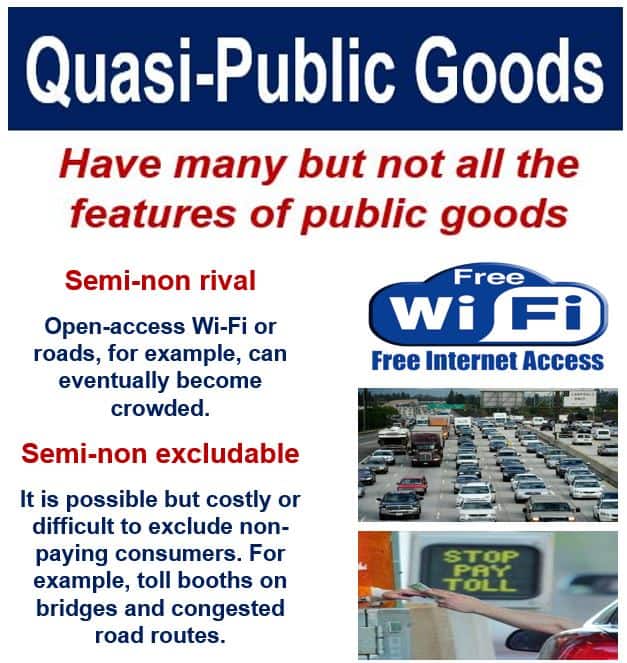Public Goods are products or things that we all consume. In fact, we cannot avoid consuming them.
They are provided to all members of a society either by the state, some other organization, or a private individual. In the vast majority of cases, they are provided by the state.
They are available for the well-being or benefit of the public.
Public goods have three features in common:
- One individual consuming them does not stop another one from consuming them; they are non-rival.
- If one person is able to consume them, it is not possible to stop another individual consuming them; they are non-excludable.
- We cannot choose not to consume them; they are non-rejectable.
The universal access to public goods ensures that every citizen benefits from the foundational services that underpin a functioning society.
Examples of public goods include flood control systems, street lighting, lighthouses, the judiciary and emergency services, clean air, national defense, sewer systems and public parks. Most basic societal goods are probably included in the list.
We take them for granted. However, there would be a massive public outcry if they vanished.Public goods – Paul Samuelson
Paul Anthony Samuelson (1915-2009), the first American to win the Nobel Memorial Prize in Economic Sciences, known by some economists as the Father of Modern Economics, is credited as the first economist to develop the theory of public goods. In his 1954 paper – The Pure Theory of Public Expenditure – he defined public goods, which he referred to in the paper as ‘collective consumption goods’, as:
“[Goods] which all enjoy in common in the sense that each individual’s consumption of such a good leads to no subtractions from any other individual’s consumption of that good.”
Some consumers of public goods can take advantage of this consumption without contributing sufficiently to their creation and/or supply – this is known as the ‘Free Rider Problem’ or the ‘Easy Rider Problem’. It is impractical for the free market to provide these public goods, because the opportunity to earn profit is significantly diminished due to this ‘free rider problem’.
Private goods
The opposite of public goods are private goods. For example, my car, a loaf of bread I bought at the supermarket, my can of Coke, are private goods.
My bread, car and drink are not available to everybody, I can exclude others from consuming them, and once they are consumed they cannot be used again.
Global public goods is a term we commonly use when referring to public goods that are available everywhere, such as fresh air.
Public goods – for society as a whole
As the name implies, public goods are items that society as a whole consumes, and not just an individual.
The taxpayer finances them. Most of us take them for granted. However, if they suddenly became unavailable, we would definitely notice it. Imagine your town, city or village if the sewer system stopped working or the police force disappeared.
Even though public goods are vital for a properly-functioning society, an issue arises when they are provided, known as the free-rider problem. A rational person, according to this problem, won’t contribute to a public good’s provision because he or she does not have to contribute to benefit.
For example, if I am guilty of tax evasion – using illegal methods to avoid paying taxes – I still benefit from the public provision of a police force and national defense by free-riding on my fellow taxpayers’ contributions.
This free-rider problem means that the state has to provide public goods. If left to just market forces, there would be a risk that no commercial enterprise would be interested in becoming the supplier, or existing private sector providers would decide to stop.
Thus, these types of goods are seen as an example of market failure, and in the vast majority of nations across the world, are provided by the government – at least in part – and funded by the taxpayer.

A Public good vs. The Public Good
In economics, there is an important conceptual difference between the meanings of A Public Good and The Public Good.
– The Public Good: refers to shared benefit at a societal level. It basically means ‘for the good of everybody in society’. It is not a ‘thing’.
– A Public Good: is, for example, the police force, the judiciary, fresh air, or the sewer system. It is one of the public goods that everybody in society uses. It is a ‘thing’.
Technological breakthroughs and public goods
Technological breakthroughs can create new or enhanced public goods. For example, street lights, which by historical standards is a very recent invention.
One individual’s enjoyment of street lighting does not detract from another human’s enjoyment. It would be virtually impossible to charge each consumer of street lighting separately according to the amount of light they used.
As new special air-filters are invented, the provision of cleaner air becomes more effective – clean air is a public good.
Scientific advances in military weapons and equipment mean that the provision of national defense – another public good – is enhanced.
The digitization of information has led to the creation of digital public goods, such as open-source software and online educational resources, which are accessible to all and benefit the entire community.
Video – What are Public Goods?
In this visual guide presented by our affiliate channel, Marketing Business Network on YouTube, we explain what “Public Goods” are using straightforward language and easy-to-understand examples.
